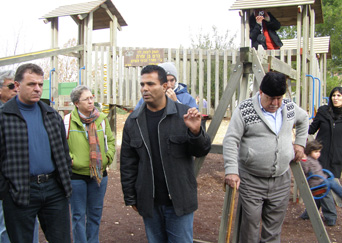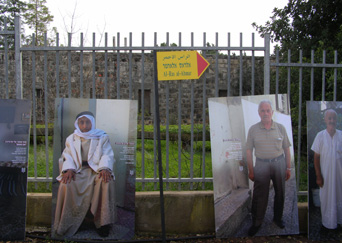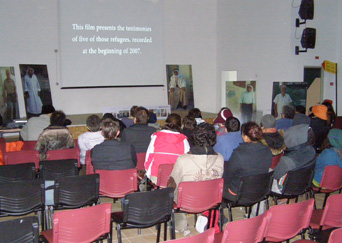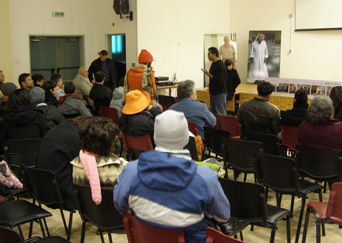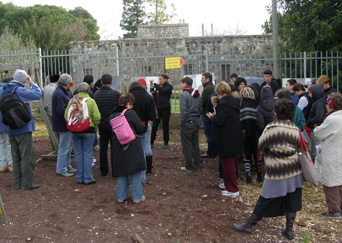The bad news from Gaza started to arrive as we drove far to the north for our tour and commemorative ceremony in the Palestinian village of al-Ras al-Ahmar. First we heard that 50 people were killed in a massive bombardment of the city by Israeli planes. The number of victims rose at an alarming rate. By early evening, when we returned to Tel Aviv, the count of Palestinians killed had reached 200.
We wanted to link the memory of al-Ras al-Ahmar with Kerem Ben Zimra, the Israeli moshav established on the land of that Palestinian village in the north, but found that the link between al-Ras al-Ahmar and Gaza, to the south, had seared our consciousness. The refugees from al-Ras al-Ahmar live today in southern Lebanon. At the end of October, 1948, the attackers left the northern side of the village open for safe passage in order to force the refugees north, toward Lebanon. That's how the Zionist leadership planned the expulsions. Almost every attack left open a route through which refugees could flee. They expelled Palestinians from the north even farther northward (to Lebanon and Syria), those in the center of the country they pushed east (to the West Bank), and residents of the south were pushed further south, (to Gaza). More than half the current population of the Gaza Strip are Palestinian refugees who were expelled from their towns and villages at the beginning of the nakba and afterwards. The inhabitants of the town of al-Majdal (today, Ashqelon), for example, were loaded onto trucks and expelled to Gaza in 1950.
During our visit to al-Ras al-Ahmar, Abu Toni, a 70-year old Palestinian from Ramleh who faithfully participates in Zochrot's tours, whispered to me that his cousin lives in Gaza. His cousin is there today, 27.12.2008, during the murderous attack on the city. Many of the refugees from Yafa, al-Lid, al-Ramlah, Isdud, al-Majdal, Yibna (Yavne, Gan Yavne), al-Jawrah (Ashqelon), al-Khasas (Erez), al-Falujah (Qiryat Gat), al-Masmiyyeh and from dozens more Palestinian towns and villages live in Gaza today. They have no escape route. One-and-one-half million Palestinians living in a death trap.
The upsetting news from Gaza contrasted with the peace and quiet we found in Kerem Ben Zimra, the little moshav. Our tour, numbering about 50 participants, entered the moshav, commemorated the village that had been destroyed, stood next to the ruins that aren't more than 10 kilometers away from Lebanese territory.
The tour was somewhat hurried, because when we'd contacted the moshav to make arrangements they refused to cooperate with us and even asked us not to go through with the event we had planned. We had prepared a booklet especially for the occasion that included testimonies by refugees from the village and from one of the first residents of Kerem Ben Zimra. We distributed it to a number of inhabitants and left many other copies with the moshav. Refugees from al-Ras al-Ahmar didn't join the tour, because they're all in Lebanon. But we did have life-size photographs of refugees (taken by Thierry Bresillon) who live in Ayn al-Hilweh and in Sidon. We placed the photographs next to the school building (that we weren't able to enter) heard a short explanation and took photos. Those photos might make their way back to the refugees who may be moved by their having been returned, unmoving, to their village.
Following our brief visit to al-Ras al-Ahmar we drove to the nearby village of al-Jish, to show a short film about al-Ras al-Ahmar in the community center, describe the "Bridging Memory" project, and connect what happened in al-Ras al-Ahmar during the nakba, and what happened in Bir'im. Nahida Zahra, a refugee from Bir'im, recounted the tragic tale of her village. The stories of the Palestinian nakba echo ever more strongly today, and current events transform it into a great tragedy that began in 1948 and still continues. The refugees from al-Ras al-Ahmar live in refugee camps in Lebanon and are still unable to return to their village. Refugees from Bir'im are scattered around the world, some even in Israel, a dubious legal decision permits them to return to their village with the army's approval, but they remain refugees, unable to return. The Israeli army is operating savagely against refugees in the Gaza Strip.
"Bridging Memory" began as an optimistic, inchoate idea, and ended in disappointment because Israelis were unwilling to become partners in thinking about the refugees whose tragedy Israel is responsible for, and whose citizens live today on the lands and even in the homes of these refugees. Israel has been oppressing the Palestinians since 1948, and continues to do so today. This oppression takes many forms, but they all lead to the same result. The refugees remain refugees, injustice persists. The terrible news from Gaza demonstrates that the story of the nakba hasn't ended, nor has the blood stopped flowing – even as these lines are written.
Israel, Gaza, truth? (A blog by one of the participants in the tour)
